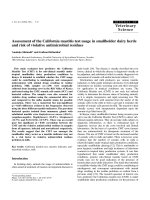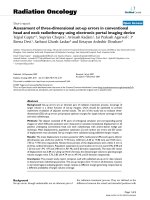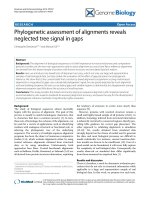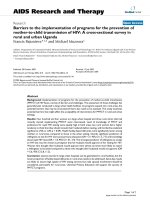Dissertation summary: Assessment of size estimation methods of HIV infection high risk populations in Can Tho
Bạn đang xem bản rút gọn của tài liệu. Xem và tải ngay bản đầy đủ của tài liệu tại đây (539.28 KB, 29 trang )
MINISTRY OF EDUCATION AND TRAINING
MINISTRY OF HEALTH
NATIONAL INSTITUTE OF HYGIENE AND EPIDEMIOLOGY
-------------------*-------------------
LE ANH TUAN
ASSESSMENT OF SIZE ESTIMATION
METHODS OF HIV INFECTION HIGH
RISK POPULATIONS IN CAN THO
Specialization: Epidemiology
Code: 62.72.01.17
SUMMARY OF PHD DISSERTATION
HANOI – 2015
The study was completed in
National Institute of Hygiene and Epidemiology
Supervisors:
1. Asc. Prof. Nguyen Anh Tuan, PhD
2. Asc. Prof. Nguyen Minh Son, PhD
Opponent 1: ……………………………………….
Opponent 2: ……………………………………….
Opponent 3: ……………………………………….
The thesis will be defended at the library,
National Institute of Hygiene and Epidemiology
on ………………….
The thesis is available at:
1. The National Library
2. The Library in National Institute of Hygiene and
Epidemiology
ABBREVIATIONS
AIC
Akaike Information Criterion
IBBS
Integrated Behavioral and Biological Survey
CI
Confidence Interval
MARP
Most at risk population
PWID
People who inject drug
WB
World Bank study (the third data source)
CI
Confidence Interval
C–RC
Capture – recapture
OR
Odd Ratios
FSW
Female sex worker
TT05/06
Rehabilitation center
Var
Variance
VCT
Voluntary HIV counseling and testing
INTRODUCTION
Rationale of the study
HIV epidemic of a country is heavily influenced from
populations most at risk to HIV (MARP), including people
who inject drug (PWID) and female sex workers (FSW). With
information on size estimation of MARP, epidemiologists can
develop models of HIV estimates and projections, policymakers can make plan for prevention, care and treatment
activities and evaluate effectiveness of implemented programs.
There have been many surveys/studies measuring HIV
prevalence and behaviors that spread HIV in Vietnam recently.
However, the questions of how many PWID and FSW have not
been addressed. The program has mainly used indirect data
from different sources with varied values due to different data
collection purposes and definition of populations, or not wide
enough coverage.
With the need of population size estimation and method
assessment, this study was conducted in Can Tho, a HIV focus
city with varied data sources, small and undispersed
geographical area for implementation, in order to achieve two
following objectives:
1. Estimating the size of populations high risk to HIV (people
who inject drug, female sex workers) applying different
methods in Can Tho in 2012-2013;
2. Assessing reliability and feasibility of a number of methods
to estimate the size of high risk to HIV populations.
New findings of the thesis
The study showed estimated number of PWID and FSW in
Can Tho city with scientific evidence achieved. The consenting
results were compared, triangulated among different methods
and additional data sources, as well as received the consensus
of experts in the field and locally.
This has been the first study so far to estimate the size of
MARP in Vietnam applying different scientific methods and
implementing at provincial level, which assessed reliability and
feasibility of applied methods.
Scientific and practical meaning of the thesis
Thesis used modern, reliable research methods in
estimating the size of high risk to HIV populations. Statistical
techniques were applied when collecting and analyzing data to
ensure accuracy, reliability, and representativeness of the
studied populations. Since then, the study has come up with
appropriate estimates and relevant evidence to evaluate each
method used.
Estimated number of two populations PWID, FSW helps
for the planning, implementation and evaluation of prevention,
intervention activities in Can Tho city. Other provinces with
similar conditions may also apply the methods that were
assessed in this study.
Layout of the thesis
The main body of the thesis consists of 120 pages, not
counting the cover pages, acknowledgement, table of contents,
lists and annexes. Specifically, the sections are distributed as
follows: Introduction 2 pages; Study objectives 1 page; Chapter
1–Overview 33 pages; Chapter 2–Methodology 17 pages;
Chapter 3–Results 36 pages; Chapter 4–Discussion 30 pages;
Conclusions 1 page; Recommendations 1 page, and List of
publications 1 page.
The thesis has 47 tables, 2 figures and 8 pictures.
The appendix includes 117 references (34 in Vietnamese,
83 in English); 17 study tools (questionnaires, data collection
forms and procedures).
CHAPTER 1: LITERATURE REVIEW
1.1. Overview of size estimation of high risk populations
Most-at-risk population to HIV is an important component
of HIV surveillance. Most countries have developed
surveillance systems for HIV/AIDS and behaviors but lacking
the ability to estimate number of MARP. The guidelines for
population size estimation were developed since 2003 and
updated in 2010, in which many countries have adopted
different methods, on different populations and in different
context, conditions.
1.2. Methods of population size estimation
There are two categories of methods: methods based on
data collected from an most-at-risk population and methods
based on data collected from the general population.
1.2.1. Census and enumeration methods
Census methods try to count every individual in an at-risk
population. Enumeration methods start with a sampling frame,
count individuals in chosen units then scale up to the size from
structure of the sample frame.
These are straightforward to calculate and easy to
understand. Where a list or sampling frame exists and
population of interest is well defined, accessible, the method is
less time and resource-consuming. With hidden populations,
dispersed geographical areas, the count cannot be completed
and is expensive to conduct.
1.2.2. Nomination method
This method starts with a limited but visible and accessible
part of a larger population. These persons are asked to refer
other individuals who share their risk behavior and so on.
Nomination accesses to hidden populations. However,
those populations tend to be highly connected, referrals may
duplicate. This starts with visible members of the group who
may not be representative of the complete population, a sample
will over-represent those with large personal networks, and low
level of interaction with other networks will be neglected in
this type of sampling. The method is useful for conducting
formative research as part of program development.
1.2.3. Capture – recapture method (C–RC)
This method bases on two independent sampling loops on
the need to estimate population. Numbers of individuals
sampled at one time, selected in a second and selected at both
times are used to estimate the population size.
This is a more scientific method but relies on assumptions
that are hard to meet (two samples must be independent and
not correlated, each population member has an equal chance of
selection, each member must be correctly identified as
‘capture’ or ‘recapture’, closed population, sample size of each
capture must be large enough).
1.2.4. Multiplier
Multiplier relies on two data sources, usually from
program data and representative surveys of target populations.
Divide number who received service by proportion reporting
receiving the service in survey to estimate the population size.
The method is straightforward with existing data. Method
assumptions include: two data sources must be independent,
the two populations for the data sources are equivalent, must
have aligned time periods, age ranges and geographic areas.
Data collected from existing sources may be inaccurate.
1.2.5. Surveys
To estimate size of hidden population, respondents in
general household survey are asked if they have high risks.
Surveys are generally easy to implement, longstanding
statistical methods, so results will be relatively easy to analyze
and defend and are politically influential. Surveys are less
useful when behavior is rare, those at risk may not be found in
households. If behavior has been stigmatized within a society,
respondents will be less truthful.
1.2.6. Network scale-up
This bases on household survey, asking about behavior of
the people they know instead of asking participants' behavior.
Estimate is based on average number of individuals the
participants know and average personal network.
A single survey can be used to create size estimates for
multiple hidden populations, and individuals more likely to
report behavior of others than their own behavior.
Disadvantage of the method is that required adjustments for
estimates are still being developed (barrier effect, transmission
effect).
1.3. Size estimation method application in Vietnam
Currently in Vietnam, size estimation of high-risk
populations has been relying mostly on the officially reported
data, program approached data, and results from small-scale
methods. These information sources are usually not sufficient
in coverage, differently and inappropriately defined, or
unreliable existing data for estimation.
1.4. Method selection for application
By excluding difficult-to-apply methods and prioritizing
available data, three selected methods were police census
(manage official data on social evils), multiplier (with multiple
existing data sources), and capture-recapture (method activities
can be managed).
CHAPTER 2: METHODOLOGY
2.1. Study subjects
PWID were male or female, 16 years old or more, injected
drug in the last 1 month, and be present in Can Tho in the study
period. FSW were female, 16 years old or more, sold sex in the
last 12 months, and is present in Can Tho in the study period.
2.2.
2.3.
2.4.
2.5.
Study site: whole 9 districts (85 communes) in Can Tho.
Time period: 2011 – 2013.
Study design: cross-sectional and using secondary data.
Procedures
For objective 1
Multiplier method relied on two sources of data. The first
source was a count from program data (number of PWID, FSW
who received HIV testing and results at voluntary HIV
counseling and testing (VCT) in the last 6 month; number of
PWID, FSW who have been in 05/06 center (TT05/06). The
second source was a representative survey of PWID, FSW. The
surveys asked respondents whether they received the service
(in the same period of time). Divide the number who received
service by the proportion reporting receiving the service in the
survey to estimate the population size. 95% confidence interval
was calculated. The two data sources were screened and
clarified for aligned time periods, age ranges and geographic
areas.
Police census method invited 523 precinct police officers
in Can Tho to participate. The managed, estimated numbers of
PWID, FSW were collected through a short questionnaire autocompleted by the police officers. Study team collaborated with
9 district police departments to organize data collection
sessions, ensuring proper and full participants.
Capture–recapture method conducted two independent
cross-sectional samples. At capture round with chain-referral
sampling method, 573 PWID and 605 FSW were distributed
unique objects. The recapture using time-location sampling
method interviewed 406 PWID and 400 FSW.
Picture 2.2. Unique objects
Number of PWID, FSW captured (n1), number of PWID, FSW
recaptured (n2) and number of PWID, FSW who were in both
samples (m) were used to estimate the size (N):
N=(n1*n2)/m; 95% CI = N ± 1.96√Var(N),
in which: Var(N) = [n1 x n2 x (n1–m) x (n2–m)] / [m2 x (m+1)].
Mapping was a step to develop sampling frame for
recapture round. Number of PWID, FSW derived from this
process was used as reference figures triangulated with results
of three main methods.
Results from different methods were compared,
triangulated and discussed among local experts, since then
agreed consenting results (median estimates and ranges).
For objective 2
The reliability of method was analyzed by evaluating
differences between derived results and consolidated results,
method assumptions achieved or not. The feasibility was
assessed by analyzing advantages and disadvantages when
implementing in the field, ability to overcome limitations, and
resource used for each method.
To evaluate independence of the two samples of capturerecapture, a data source from a cross-sectional survey on PWID
and FSW in Can Tho in the same period (WB study) was used,
in which participants were asked if they received unique
objects (in capture sample) and being interviewed (in
recapture) previously. Two techniques used to analyze were
Wittes (calculated Odds Ratio, independent if OR=1,
dependent if OR~1) and Log-linear modeling (found the
optimal model based on p-value and Akaike Information
Criterion (AIC).
2.6. Ethical consideration
The study protocol and forms was reviewed and approved
by the National Institute of Hygiene and Epidemiology Internal
Review Board.
CHAPTER 3: RESULTS
3.1. Estimated size of PWID, FSW in Can Tho in 2012-2013
3.1.1. Results of multiplier method
Table 3.5: Results from VCT – Recapture multiplier
Indicators
PWID
FSW
674
455
33%
62%
Average estimated size
2,017
737
Low estimated size
1,864
688
High estimated size
2,169
806
Number of clients to VCT for HIV testing
and received result in 3-8/2012
% of the recaptured came to VCT for HIV
testing and received results in 3-8/2012
This multiplier estimated 2,017 PWID [1,864–2,169] and
737 FSWs [688–806].
Table 3.9: Results from TT05/06–IBBS multiplier
Indicators
PWID
FSW
1,268
306
45%
6%
Average estimated size
2,791
5,352
Low estimated size
2,634
4,752
High estimated size
2,949
5,951
Number of people ever been to Can Tho
05/06 center
% of IBBS participants ever been in Can
Tho 05/06 center
Average, low and high PWID, FSW estimates were 2,791
[2,634–2,949], 5,352 [4,752–5,951] respectively.
3.1.2. Results of police census method
There were 1,201 drug users and 1,043 PWID in
community estimated by participated precinct police officers.
High estimation of FSW was 809, 366 for low estimate
and 535 on average in Can Tho.
3.1.3. Results of capture – recapture method
Table 3.19: Results from capture - recapture
Indicators
PWID
FSW
# people received object
547
590
# people interviewed
374
374
129
125
1.621
1.768
1,423–1,818
1,545–1,992
# people received object and
interviewed
Average estimates
95% confident interval
Average estimates and 95% CIs of PWID and FSW were
1,621 [1,423–1,818] and 1,768 [1,545–1,992] respectively.
Table 3.20: Summary of results from applied methods
Methods
PWID
FSW
1,043
809
VCT–recapture multiplier
2,017 [1,864-2,169]
737 [668-806]
TT05/06–IBBS multiplier
2,791 [2,634-2,949]
5,352 [4,752-5,951]
1,014-1,588
1,113-1,733
Police census
Mapping
Capture – recapture
1,586 [1,393-1,779] 1,765 [1,542-1,989]
For PWID, multiplier method estimated the highest
numbers, followed by C-RC, mapping, and police census.
From highest to lowest estimates for FSW group were
TT05/06–IBBS multiplier, C-RC, mapping, police census, and
VCT–recapture multiplier.
3.1.4. Results of additional methods
High and low PWID estimates from mapping were 1,014–
1,558, and 1,113–1,733 for FSW. When conducting Wisdom of
the Crowd method, 12 local experts in Can Tho estimated
1,442 [1,000–2,000] for PWID and 1,771 [1,200–2,300] for
FSW group.
3.2. Reliability and feasibility of the applied methods
3.2.1. Programmatic multiplier
Table 3.24: Differences between multiplier and consolidated results
Multipliers
Result
Distance
Difference
VCT–recapture
2,017
417
26%
TT05/06–IBBS
2,791
1,191
74%
PWID
FSW
VCT–recapture
737
-963
-57%
TT05/06–IBBS
5.352
3.652
215%
Results from multipliers for both groups were much
different compared to the consolidated results (1,600 PWID,
1,700 FSWs).
Existing program data (VCT and TT05/06) was not
sufficient enough in terms of coverage (especially for FSW
group) and information for adjustment as required by the
method assumptions.
The implementation process lasted in 15 days, equivalent
to 45 person-days with a total budget of over 21 million dongs.
3.2.2. Police census
This method had the process to ensure data coverage and
to avoid data duplication and omission.
Table 3.27: Differences between police census and consolidated
results
Police census
Result
Distance
Difference
Managed in community
814
-786
-49%
Estimated in community
1,043
-557
-35%
Managed in community
535
-1,165
-69%
Estimated in community
809
-891
-52%
PWID
FSW
The differences ranged from 35% (estimated PWID) to
69% (managed FSW).
The police census was conducted in 15 days, or 96 persondays, with 73 million dongs.
3.2.3. Capture – recapture
Using the third data source (WB) to assess the
independence of the two samples. Among 89 survey
participating PWID, 48 respondents had received unique
objects, 25 people were interviewed and 20 people were
present at both rounds. Among 91 FSW, there were 42, 36, and
24 people participated in capture, recapture and both samples,
respectively. Each data pair was calculated based on the C-RC
formula to estimate the average results. Low and high estimates
were given by calculating 95% confident interval.
Table 3.31: Results of data pairs – PWID group
Recapture
n1 = 547, n2 = 374, m = 129
+
Var = 9,685
+ 20
5
25
SD = 98.4
Capture
- 28
36
N = 1,586 [1,393 – 1,779]
OR = 5.1 [1.6 – 18.0]
48
89
WB
Recapture
+
-
+
20
28
-
109
390
129
WB
+
-
Capture
+
20
109
5
240
25
48
547
129
374
n1 = 374, n2 = 89, m = 25
Var = 45,752
SD = 213.9
N = 1,331 [912 – 1,751]
OR = 2.6 [1.4 – 5.1]
n1 = 89, n2 = 547, m = 48
Var = 8,822
SD = 93.9
N = 1,014 [830 – 1,198]
OR = 8.8 [3.0 – 27.6]
All 3 data pairs had OR which higher than 1, the most
dependent sources (WB and Capture with highest OR=8.8)
were merged, then repeated calculation of estimates with
merged source and recapture, when n1=374, n2=636, m=134,
calculated N=1,775 [1,562–1,988].
Table 3.32: Results of data pairs – FSW group
Recapture
n1 = 590, n2 = 374, m = 125
+
Var = 12,977
+
24
12 36
SD = 113.9
Capture
18
37
N = 1,765 [1,542 – 1,989]
OR = 4.1 [1.5 – 11.1]
42
91
WB
Recapture
+
-
+
24
18
-
101
447
125
WB
+
-
Capture
+
24
101
12
237
36
42
590
125
374
n1 = 374, n2 = 91, m = 36
Var = 13,194
SD = 114.9
N = 945 [720 – 1,171]
OR = 5.9 [3.0 – 11.9]
n1 = 91, n2 = 590, m = 42
Var = 19,007
SD = 137.9
N = 1,278 [1,008 – 1,549]
OR = 4.7 [2.2 – 10.4]
For FSW group, the most dependent sources WB and
Recapture (OR=5.9) were merged, then created a new data pair
of WB/Recapture – Capture, with n1=590, n2=465, m=143,
N=1,919 [1,692–2,146].
Results from Log-linear modeling in table 3.35 showed the
estimates of hidden PWID, plus the number already know
PWID (740 participants in three data sources), from which,
total PWID at low, average and high estimates were calculated.
All model had similar estimates, with about 1,500 PWID.
There was no model indicating independence of the data
sources when all p values were lower than 0.05. The smallest
AIC value was in P1xP3 model.
Table 3.35: Number of PWID estimated from each model
Model
Hidden
Total
Low est. High est.
Independence
699
1,539
1,397
1,707
P1xP2
720
1,560
1,408
1,742
P2xP3
510
1,350
1,159
1,615
P1xP3
835
1,675
1,493
1,897
P1xP2+P2xP3
517
1,357
1,142
1,689
P1xP2+P1XP3
855
1,695
1,522
1,979
P1xP3+P2xP3
1,728
2,568
1,546
5,715
P1xP2+P1xP3+P2xP3
4,552
5,392
2,351
15,940
For FSW group, P1xP2 model had the lowest AIC value,
with estimate of 1,770 people.
2,000
1,655
1,500
1,770
1,744
1,795
1,925
1,414
1,000
500
-
Figure 3.2: Number of FSW estimated from each model
1,607
Estimates of PWID with differences under 15% were twodata-source C–RC, three-data-source C–RC, optimal model.
For FSW, these were also two-data-source C–RC, three-datasource C–RC, optimal model.
Table 3.36: Differences between C–RC and consolidated results
C – RC
Result
Distance
Difference
Capture - recapture
1,586
-14
-1%
Capture - WB
1,014
-586
-37%
Recapture - WB
1,331
-269
-17%
Merged C–RC
1,775
175
11%
Optimal model
1,695
95
6%
Capture - recapture
1,765
65
4%
Capture - WB
1,278
-422
-25%
945
-755
-44%
Merged C–RC
1,919
21
13%
Optimal model
1,770
70
4%
PWID
FSW
Recapture - WB
C–RC (including mapping process) was implemented in
two months (603 person-days) with total 324 million dongs.
CHAPTER 4: DISCUSSION
4.1. Estimated size of PWID, FSW in Can Tho in 2012-2013
4.1.1. Results from programmatic multiplier
Some method assumptions were met (aligned time periods,
age ranges and geographic areas). PWIDs, FSWs received
program services (VCT, TT05/06) and those did not have the
same chance of being selected to surveys (RC, IBBS). RC and
IBBS were representative surveys. Program data collected from
all VCT sites in Can Tho warranted the coverage.
The program data had limitation. There was not software
and coding system for client management. Both VCT and
TT05/06 data sources were counted as number of visits, not
number of people, although some adjustments were done to
correct a number of people but these were indirect methods.
With self-reported VCT information of risk behaviors, large
numbers of clients were classified into "other" category in the
logbook. This was an important reason resulting much lower
number of FSWs compared to other methods (737 FSWs).
TT05/06 data was clarified to be equivalent with IBBS source
but in reality some criterion such as "number of people" or
"present in Can Tho” were difficult to achieve. Definition of
population was not strictly equivalent, while RC and IBBS
sampled PWIDs "who injected in the last month" and FSW
"who sold sex in the last 12 months" but VCT and TT05/06 did
not have this information. Characteristics of PWIDs and FSWs
who were managed in TT05/06 differed from those participated
in HIV/AIDS surveys, led to low chance of being selected in
both data sources, resulted higher estimated size compared to
other methods (2,791 PWIDs, 5,352 FSWs).
4.1.2. Results from police census
System, criteria, and number of precinct police officers in
Can Tho were identified prior to method implementation to
invite proper and enough participants, ensuring coverage and
avoiding duplication, omission of data.
Several factors resulted in underestimates. The first was
social desirability, police officers tended to report lower than
the actual number. Data of sex work was not officially
managed and only accessed to entertainment establishments
such as restaurants, karaoke bars, massage and public venues
of parks, streets, omitted some channels such as sex work via
phone, internet. Estimated number of PWID from this method
was not much different from the official reports (1,201 versus
1,187). Local experts also recognized that this result account
for 70% the actual number.
4.1.3. Results from capture – recapture
Assumption "closed population" was met since the time
between two samples capture and recapture was short, avoiding
big events. Matching information could be identified by
distributing and recapturing unique object. Both capture and
recapture samples were random, representative and weights
were used when analyzing data.
In fact, incentives and nice unique objects led to
duplication samples. Recapture based on mapping frame
reached only PWID and FSWs in hotspots, not hidden ones
(41% of PWID said they usually inject at home).
Mapping results showed higher numbers than IBBS 2013
and program outreach data. This mapping exercise covered
entire Can Tho city, not just in some sentinel districts as
implemented before. According to the local experts, with small
and undispersed geographic like Can Tho, estimates from
mapping reflected the actual number. This mapping result
primarily served to sampling frame rather than collecting
sufficient information for the purpose of size estimation of
high-risk populations such as frequency and number of
hotspots per week.
"Wisdom of the crowd" was conducted with 12 local
experts showed relatively consistent estimate compared to the
consenting results from different methods. An interesting thing
of this method was that in the discussion although experts said
high estimated number of FSW from police census (809 FSW)
but when being asked to anonymously provide actual number
of FSW, the lowest number was 1,200. The difference between
providing estimate numbers in writing (anonymous) and
officially reported figures reflected influence of "social
desirability".
4.2. Reliability and feasibility of the methods
4.2.1. Programmatic multiplier method
Results of this method had much difference compared to
the consolidated results in both two PWID and FSW groups.
Some data requirements were not met such as equivalence of
population definition, specificity of program data (VCT,
TT05/06), sufficiency of reported information, and information
for screening of population definition. Experiences from the
previous studies had shown that quality of existing program
data be inconsistent and time-consuming to adjust. These two
data issues indicated low reliability of the results.
To be used for the purpose of size estimation with
multiplier method, data reporting system need to be adapted to
meet the method data requirements. Data management software
and identification number system for each individual are
needed but relatively difficult in practice due to insufficient
conditions and VCT program allowing anonymous customers
in order to encourage usage of service. Despite of simple and
low-required resources, the feasibility of the method
application using VCT and TT05/06 data is limited since
improvement of program data quality is very difficult.
4.2.2. Police census method
In this method, process to ensure coverage and to avoid
duplication of data was guaranteed. However, major
encountered issue was to collect estimated actual number, with
the two reasons stated in the previous section. There were
reporting requirements of official sectors and social desirability
of respondents. These two factors are in fact very difficult to
overcome within the study. With FSW group, underestimated
results showed inappropriate application of this method, one
more important issue was that sex work has been not included
in rehabilitation center anymore.
The police census method had advantages of direct
calculation, understandable to policy makers, not highly
required statistics and sampling, less time-consuming and
resources. However, though it was done in a small and
undispersed geographical city, for two populations of PWID
and FSW, this method had difficulties to get reliable results
feasibility.
4.2.3. Capture – recapture method
By analyzing the procedures done in the field,
triangulating with additional data sources, results of this
method were closest to the consolidated values. To assess the
method assumptions in terms of step observation (tracking and
supervising activities in the field) and qualitative analysis
(interviewing study members who implemented this method
activities), the steps required by method were done strictly and
properly. However, when using the third data source to
analyze, both techniques applied to assess the independence of
two samples (Wittes and Log-linear modeling) showed
underestimates for both PWID and FSW groups, as well as
difficulties in reaching hidden individuals (who did not come
to hotspots, were less likely to be sampled). The third data
sources used for independence assessment was not well
prepared in terms of sample size and clear identifying
information of individual (to determine participants were
captured, recaptured or sampled in both rounds), these issues
limited accuracy of the results. Experiences from research
studies and project activities have indicated that these
limitations can be overcome in preparation and implementation
in the field. Regarding resources used, this method lasted
relatively long time period (60 days, 603 person-days) and
bigger expenses than the other methods.
This method gave relatively closed results compared to the
consolidated numbers, implementation processes met method
assumptions, and limitations can be improved if well prepared
and implemented, although these require complicated statistical
analysis to assess the independence of two samples. The
problem with this approach is how to reduce the resources
needed to be feasible in the future. The experience of other
countries and recommendations of the technical working group









